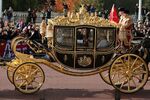Public transport
Public transport was, until the advent of slave trading, reserved for the rich and powerful. Kings, pharoahs and successful tax collectors built luxurious vehicles at public expense in which they could get from the royal palace to places they fancied and back again in relative comfort.
These vehicles were public only in the sense that the public had paid for them, as none but the rulers and their chosen retinue were allowed entry.
Slavery and public transport
Some societies that excelled at collecting slaves found that they actually had too many for the available jobs. As there is no point in feeding and housing unemployed slaves, they began to capitalize on their competitive advantage by selling the excess to other societies. This involved moving the slaves to the slave markets and eventually to wherever they could slave for their new owners.
Slaves were sometimes transported over considerable distances and their owners did not want excessive wastage in transport. They convinced the rulers that public transport should be provided for the slaves. So, barges, galleys, wagons and sledges replaced the walking and swimming that had previously been necessary. It was once thought that modern public transport had evolved from these beginnings, but the true answer was yet to be discovered.
The emergence of private transport
The rich and powerful, having allowed public transport for slaves, were soon aware that they no longer had bragging rights for lounging around in vehicles built at public expense. Although the vehicles built for slaves were in no way as luxurious as those of the rulers, said rulers embarked on a program of building even more outrageously luxurious transport for themselves.
While this did effectively distinguish their vehicles from those of the slave traders, it brought many of their societies to the brink of bankruptcy, and the resulting social discontent forced most rulers to pay for their own vehicles, albeit from the various forms of tribute that they collected from the people anyway.
Innovation in private transport
Now that the rulers used nominally private, rather than public, transport, the race to display one's position in society by the transport one used began. It was usually a bad idea to imitate the Rolls Royals that the rulers possessed too closely, but the ingenuity of carriagemakers and suppliers of draft animals was equal to the challenge.
Germ Theory of public transport
At this point, the real beginning of modern public transport occurred. All those pathogens, like smallpox, bubonic plague and syphilis, noticed that the opportunities for their transmission from the sick to the healthy in public transport were far superior to those among people not using public transport. Evolution being what it is, all those diseases transmitted by contact were selected for genes that would encourage people to use public transport. Therefore, any healthy people who ventured onto public transport were soon infected as they were surrounded by sick people.
Exposure to the causative organisms is enhanced by travelling to the nearest place where public transport can be engaged and waiting for it to arrive in inclement weather.
This was only discovered when genetic analysis allowed scientists to demonstrate the connection between these genes and behavior in the afflicted and led to the Germ Theory of Public Transport. While this is accepted among well over 90% of scientists, there are a large number of Germ Theory deniers, particularly among those employed in the public transport industry.
Consequences of public transport
Apart from the disastrous effect of public transport on public health through the transmission of innumerable respiratory and other diseases, other negative influences of public transport have been observed. For one, the disruption to private transport may well be the major influence on the supposed inefficiency of private transport. Not only do buses commandeer entire lanes on major roads for their use. They often invade the other lanes. crawling along while choking any road users behind them with noxious fumes.
Public transport rage
Public transport rage is common in some societies. Passengers occasionally succumb to "cattle truck" syndrome and begin to behave destructively. This can escalate to detonating weapons of mass transport destruction while en route, causing numerous fatalities, not least among those pathogens that have been taking advantage of the cosy conditions onboard.
The controllers of the public transport vehicles are not immune to this. Apart from driving while under the influence of a wide range of intoxicating substances, they are also partial to talking on their mobile phones, watching porn on the video safety system and sometimes leaving the vehicle entirely to pursue some entertainment.
Modern public transport and slavery
There have been a number of changes in the business of slave trading over time. It is no longer de rigeur to own slaves, although a surprising number of slave owners seem unaware of this. For some time it has been considered proper to rent slaves rather than own them. By ensuring that there are many people who cannot support themselves by the traditional occupations of subsistence farming, hunting and gathering or slave trading, it is possible to rent these people by the hour to perform useful work.
As these people are usually poor, they are often unable to afford modern private transport. By utilizing modern public transport, they are soon afflicted by disease and even less likely to be able to afford modern private transport. This vicious cycle keeps them in a condition in which they must offer themselves for rent, but are typically unable to break out of the cycle by obtaining private transport. The people who rent them would prefer to have healthier rent-slaves, but those involved in public transport are quite satisfied with things as they are.
Modern public transport and Zombies
Zombies have finally caught on to the idea that public transport is a great way to recruit new zombies. Lurching about after the average healthy non-user of public transport is far too much effort for the walking dead and often unsuccessful to boot. A non-zombie on a bus or train full of zombies is a dead cert for a new zombie. This suits the zombies quite well as they can just ride around on public transport safely until the vehicle is full of zombies and no one else can enter. At this point they must leave and attempt to start another zombie colony on another vehicle. Public transport departments are reluctant to acknowledge the growing number of zombies using public transport for fear of further reducing patronage by non-zombies.













